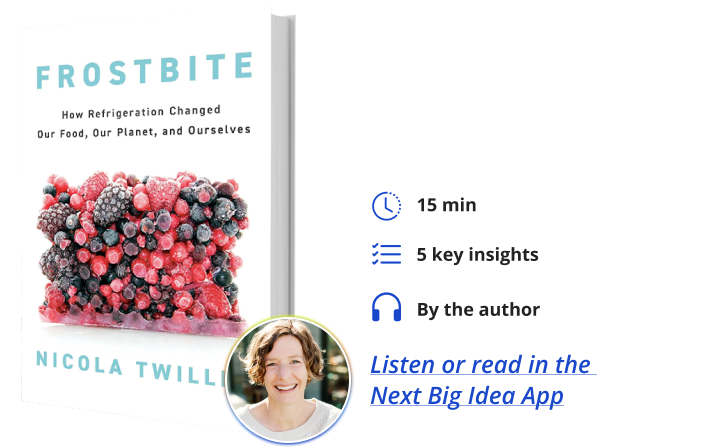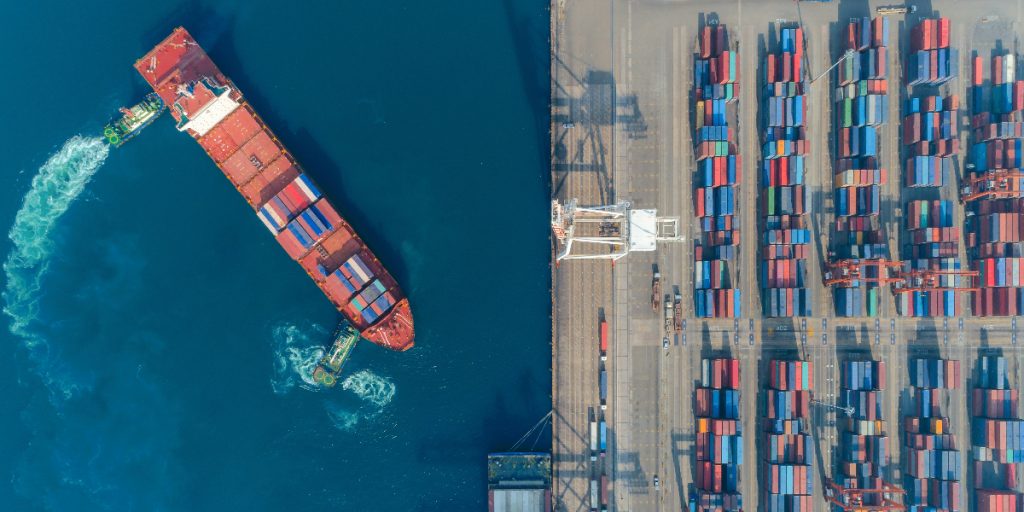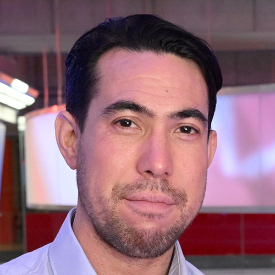Nicola Twilley is the coauthor of Until Proven Safe: The History and Future of Quarantine, named one of the best books of 2021 by Time, NPR, The Guardian, and the Financial Times. She is cohost of Gastropod, the award-winning and popular podcast that looks at food through the lens of science and history, and a frequent contributor to The New Yorker.
Below, Nicola shares five key insights from her new book, Frostbite: How Refrigeration Changed Our Food, Our Planet, and Ourselves. Listen to the audio version—read by Nicola herself—in the Next Big Idea App.

1. The life-extension techniques we’ve developed for produce are incredible.
You might wonder, how can the humble fridge—this perennially overlooked essential—hold any surprises? Well, it’s neither humble nor essential, for starters. Controlling fire arguably made us human—controlling cold has been just as consequential. Understanding its impact is the key to transforming our food system and avoiding climate apocalypse while making what we eat tastier, better for us, and better for the planet.
Produce is alive, it’s still breathing—or, technically speaking, respiring—all the way up to when we eat it or when it finally decomposes. Fruit and vegetable logistics is thus the dark art of prolonging the death process. The main way to do that is by slowing down how fast, say, an apple is breathing. Keeping it cold will do that: everything, including metabolism, happens more slowly in the cold.
But, in a story, I dug deep into the national archives to tell, researchers in England in the 1920s put apples in Vaseline-lined coffins and discovered that you could slow an apple’s respiration down even more by keeping it cold and changing the atmosphere it breathes in. Today, apples in Washington State are stored in synthetic atmospheres precisely tailored to each variety: no more than 1.5 percent carbon dioxide for a Pink Lady, less than 1 percent oxygen for a Red Delicious, and so on. In the most advanced warehouses, the apples control the atmosphere—the blend of gases is dynamically adjusted to match how fast the fruit is breathing.
If you’re eating an American apple in June, you’re taking a bite out of Sleeping Beauty: that apple was revived from suspended animation to meet your lips with the same crunch and juiciness as it had when it was put to sleep a year before. If that’s not wild enough, meet your salad bag—and the handle-bar mustached Hawaiian shirt-clad hero who designed it. Yes, it looks like an ordinary plastic bag, but it’s actually an advanced respiratory apparatus, combining different layers of semi-permeable membranes that regulate the diffusion of gases to match the precise needs of the baby leaves inside. And that spring mix blend is combined in a specific ratio to balance out faster breathing leaves, like baby lettuce, with more chill ones, like radicchio. Then you open it and squeeze out the air to fit it in your crisper drawer, breaking the hearts of post-harvest physiologists everywhere.
2. The meaning of freshness was transformed by refrigeration—and must change again.
A century ago, many Americans were afraid to eat the zombie foods that emerged from cold storage warehouses. In Frostbite, I tell the story of a banquet held in 1911, in Chicago, where everything served had been refrigerated: it was designed to show Americans you could eat cold-stored food and live to tell the tale. A century later, in the US, attitudes have flipped. Freshness, which used to mean something harvested recently and nearby, is now determined by association: fresh foods require refrigeration, therefore refrigerated food is fresh. This belief system is so strong that to convince reluctant Americans to drink Silk Soymilk, its founder paid extra slotting fees to have it sold in the refrigerated section, even though it didn’t need to be chilled.
“The ability to preserve perishable food without changing its external appearance has made it much harder for eaters to know what foods are truly fresh.”
But refrigeration has also created tremendous uncertainty. The ability to preserve perishable food without changing its external appearance has made it much harder for eaters to know what foods are truly fresh. Many Americans at the end of cold-extended food chains now rely on a sell-by or best-before date to judge freshness. That leads to vast amounts of food being wasted: according to the FDA, an estimated 26 billion pounds of likely perfectly safe and edible food is thrown away each year because the date on its label has passed. That’s a huge problem: if global food waste were a country, its greenhouse gas emissions would be the third largest in the world, right behind China and the US. Redefining freshness is surprisingly possible because we’ve done it before (quite recently), and it is also both high stakes and incredibly urgent.
3. The actual Arctic is melting while the artificial Arctic is expanding.
Although we rarely think of it as a connected whole, the artificial winter we’ve built for our food to live in and travel through is already 5.2 billion cubic feet in size and expanding rapidly. It’s invisible—most of us have never been inside the underground cheese caves, gigantic tank farms, and banana ripening rooms I take readers to. But it’s vast and still growing.
If the rest of the world builds an American-scale cold chain—which, as I discover in the chapter set in Rwanda, is the plan, encouraged by billionaires like Bill Gates, as well as many at international development agencies—that 5.2 billion cubic feet will soon be more like 30-some billion. Meanwhile, the Earth’s natural cryosphere—the polar ice caps and glaciers—is melting faster than even our worst-case scenarios predicted.
The two are directly related. There are a couple of main problems: cooling is power-hungry, and many of the chemicals used as refrigerants are super greenhouse gases. More than a sixth of the world’s fossil fuel energy is used for refrigeration already. Project Drawdown lists refrigerant management as the number one solution to global warming, in terms of potential impact. If we continue cooling our food the way we do now, climate change will guarantee that there won’t be a harvest to preserve.
4. Is refrigeration a blessing?
This seems like a no-brainer. Of course, refrigeration’s a good thing! Certainly, ice cream and cold beer are good things. But the jury is definitely out on the long-term benefits of refrigeration, at least in how we’ve implemented it. In terms of human health, economic inequality, the environment, food safety, food waste, biodiversity, or even the composition of the upper atmosphere…as many, and arguably as significant, problems have been created or enabled by refrigeration as have been solved by it. The long and short of it is that our food system is frostbitten—it has been injured by its exposure to cold.
“Rethinking our relationship to refrigeration can help fix so much else that is broken.”
The time for this realization is now, because the rest of the world is building an American-style cold chain. Rethinking our relationship to refrigeration can help fix so much else that is broken, from the disaster that is the Western-style diet to the environmental externalities of industrial farming to the decline of walkable city centers to, yes, climate change. We don’t have to throw out our fridges, but we can and should reduce our dependence on the cold chain.
5. Keeping things cold is not the only or maybe even the best answer to food preservation.
In the 1800s, food preservation was the big problem facing the developed world. Cities were larger than ever before, scientists had begun to be able to identify essential nutrients, starting with protein, and the great minds of the era were wrestling with how to get enough meat and dairy to urban factory workers. Scientists knew that keeping food cold using ice would prevent it from going bad, but they all agreed that cold was only of limited usefulness when it came to this challenge of large-scale food preservation. The promising R&D efforts of the era focused on things like coatings, injections, and fumigation. That all changed when a high-school dropout from Boston turned ice-harvesting into a global business, which inspired innovators to create machines that could mimic nature and freeze water—and, ultimately, keep food warehouses, trucks, and factories cold.
But here’s the thing: when you have a hammer, everything looks like a nail. With the ability to make cold on demand, refrigeration became the answer to food preservation. But let’s not confuse means with the end. For most perishable food, we want to preserve freshness, not keep things cold. So the future of the cold chain might not be cold.
But, as Toby Peters, the world’s first professor of cold economy, told me: cooling is already the Cinderella of the energy debate. Less than a quarter of one percent of all engineering R&D is spent on cooling, even though it’s one of the most important drivers of climate change. Even less is spent on developing alternate methods of food preservation. But remember those coatings that folks in the 1800s were so hot for? Well, there’s a company working on coatings that can extend a fruit’s shelf life by four times, which is exactly what refrigeration does. Let’s invent the future of food preservation with the goal of a delicious, sustainable, resilient food system in mind.
To listen to the audio version read by author Nicola Twilley, download the Next Big Idea App today:
































